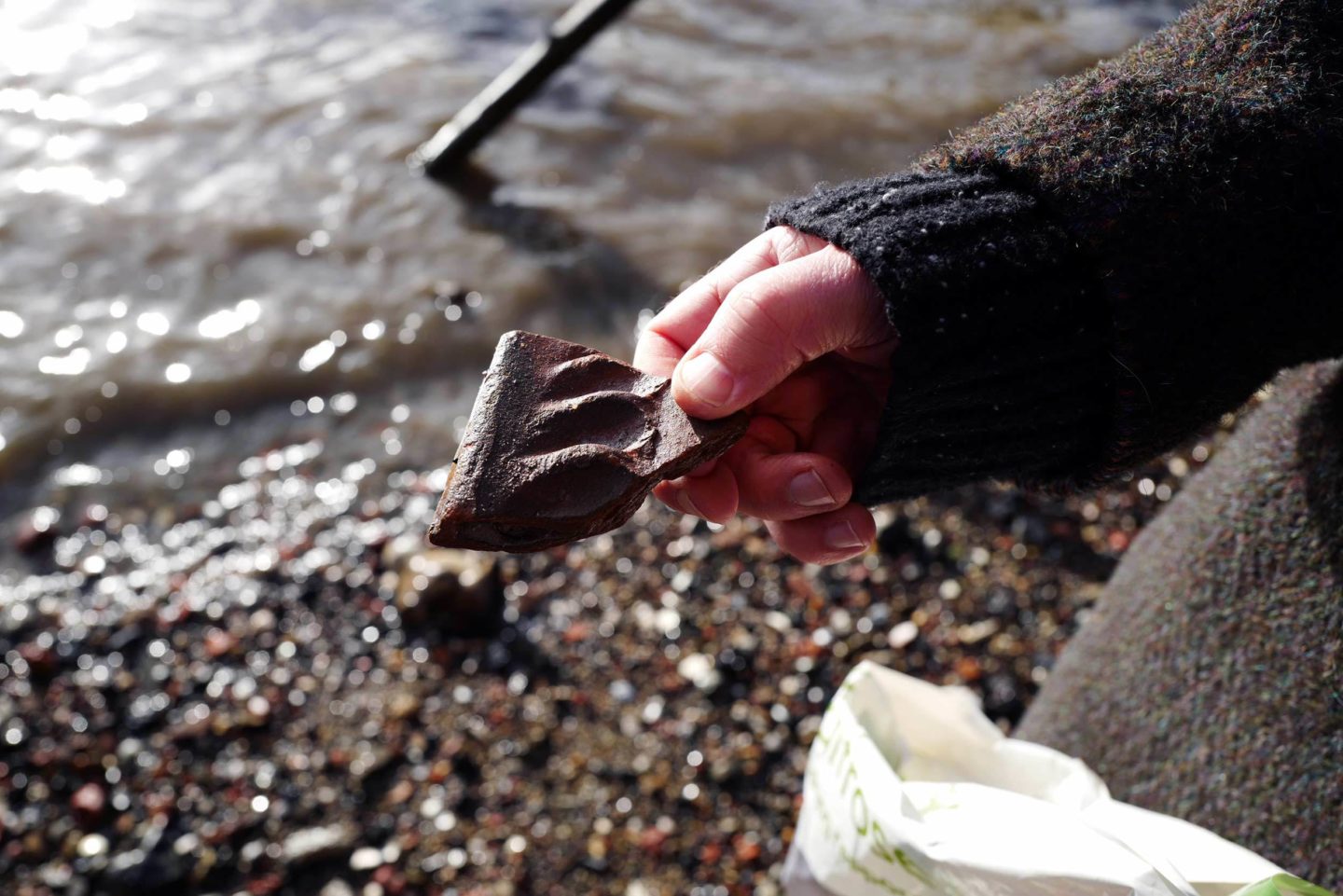
I have an unusual hobby. I spend my spare time covered in mud and often on my knees, with my nose barely inches from the Thames foreshore. I am one of London’s mudlarks, an amateur historian and a searcher for past lives. I hunt for London’s orphaned objects, the lost and rejected, the dumped and abandoned. They are revealed by every low tide and I collect only what lies on the surface. I have just one chance to rescue them before they are washed away forever on the next tide.
Over the years I have rescued countless coins, old buttons and buckles; Medieval chain mail, Roman game counters, a complete Tudor shoe, children’s toys dating back to the 14th century, hundreds of clay pipes and buckets of pottery shards. My obsession is fed by the unpredictable; I never know what I will find next.
I slip down onto the foreshore whenever I can, away from the chaos and crowds to another London, peaceful and open. There is nature here, in the water and beneath my feet. Once I found a seahorse, flat fish scoot over my boots in the shallows, cormorants wrestle eels and crystal clear shrimps are brought in on the waves created by the river traffic that passes up and down from early morning until well into the night.
My obsession has taken me to the foreshore at night-time too, to exploit the low spring tides that uncover areas that are usually several feet under water. The river is at its most evocative at night when the ghosts of London-past climb out of the mud. But even here the stones and gravel are lit by the pale orange glow of the city, nowhere in London is ever truly dark.

The bridges that cross the river are an added protective layer from the city. These dripping urban caves block out light and sound. I use them to shelter from the elements: rain, hail, even snow. Beneath them I have found lucky pennies tossed in from above, lost sunglasses and wedding rings that have been cast into the water by the free and broken hearted.
Few see the beauty of London’s bridges from beneath: the latticed iron and sturdy piers that break the river’s journey, sending it swirling and spinning in whirlpools and corded currents. The thick concrete columns that support Cannon Street Bridge are a reminder of the Roman villa that lies beneath the Station and on really low tides I can touch the algae covered stones that support Blackfriars Bridge.
Southwark Bridge is tall like the roof of a cathedral; London Bridge is out of reach on all but the lowest tides; and with its steeples hidden from view Tower Bridge is less splendid, just an ordinary bridge. Suitcases zing over Millennium Bridge, while ‘the chewing gum man’ toils back and forth over it, painting and enameling squashed gum into miniature works of art. One day he’ll keep on going, through the doors of the Tate Modern, then he’ll be famous he says. Beneath Blackfriars Railway Bridge a secret river, hidden from above, dribbles through a drain into the Thames. This is the once famous Fleet, now a pathetic shadow of its former glory.
Some bridges were only meant to be seen from the river. From the foreshore, the ladies on Vauxhall Bridge are glorious in their detail and the carved birds on Blackfriars can only be fully appreciated from below. Where the sea was once thought to meet the river, those on the eastern side are sea birds and those facing west are the birds of the river.

It is quiet under the bridges, save for the dull thud of trains and lorries passing overhead. City sounds drift down from the – police sirens, traffic noises, people shouting to the tourists as they pass below on crowded boats. As commuters trip trap across them, most are oblivious to the secret world beneath them. Mudlarks are the trolls beneath London’s bridges and we have a unique eye on the city.
Over 2,000 years the Thames has changed from a wild river spread over a wide flood plain to a constricted, crowded highway. When the Illuminated River project comes to fruition and the bridges are given the splendour they deserve, it will metamorphasise again into a work of art. London’s heart will emerge from the darkness bejeweled.
NOTE: Anyone can visit the Thames foreshore to see the underside of the bridges for themselves, but please be aware, the river is a potentially dangerous and unpredictable place. Stairs are often slippery, in places there is deep mud and once the tide turns it is easy to get cut off. If you want to try mudlarking you will need a permit, which is available from the Port of London Authority. Alternatively, a guided tour through the Thames Explorer Trust is a great way to get a taste of what it’s all about.



